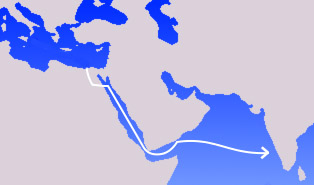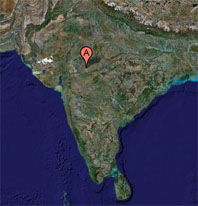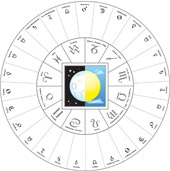The Transmission of Hellenistic Astrology to India
 Over the course of the past century researchers have discovered that Hellenistic astrology was transmitted to India sometime around the 2nd century CE. Inklings of this transmission were noted in the late 19th century, for example by the historian August Bouché-Leclercq in his 1899 work L’astrologie grec, although it was not until the middle part of the 20th century that the source of this transmission was confirmed and identified in a work known as the Yavanajātaka.
Over the course of the past century researchers have discovered that Hellenistic astrology was transmitted to India sometime around the 2nd century CE. Inklings of this transmission were noted in the late 19th century, for example by the historian August Bouché-Leclercq in his 1899 work L’astrologie grec, although it was not until the middle part of the 20th century that the source of this transmission was confirmed and identified in a work known as the Yavanajātaka.
This was not a simple matter of one tradition lightly influencing another though, but rather, the text that was transmitted to India in the 2nd century actually formed the basis of virtually all later traditions of horoscopic astrology on the Indian subcontinent.
The pioneer of this discovery was a scholar named David Pingree. Pingree, who sadly passed away in 2005, was a historian of science that was fluent in a number of ancient languages, including Sanskrit, Greek, Arabic, Pahlavi, Latin, and Akkadian, as well as a several other modern European languages. Although Pingree did not believe in astrology as a legitimate phenomenon, he did acknowledge its place as a legitimate science in the ancient world that is deserving of serious academic study, and he dedicated his career to studying the history and transmission of the subject.
For his doctoral dissertation Pingree edited, translated and wrote a commentary on the Yavanajātaka.[1] The main purpose of his dissertation was to compare the astrological doctrines contained in theYavanajātaka with those of various astrologers from the Hellenistic tradition, in order to demonstrate that the Indian tradition of horoscopic astrology was largely derived from Hellenistic astrology, and that theYavanajātaka was in fact the principle source of this transmission.
Pingree accomplished this by showing that the Yavanajātaka was the earliest Indian text on horoscopic astrology, and that it formed the basis of virtually all later traditions of astrology in India. He pointed out that the Yavanajātaka, which actually means ‘Horoscopy of the Greeks‘, was actually a Sanskrit translation of a Greek astrological text, and that the vast majority of doctrines contained in the text could be traced back either directly or indirectly to Hellenistic sources.
The Origins of the Yavanajātaka
According to Pingree, the original Greek text of the Yavanajātaka was probably composed in Egypt sometime in the 1st century CE, likely in Alexandria.  In the early 2nd century it was transported on a trading ship to the western coast of India where a number of Greek trading colonies were set up, some of which were still left over from the earlier conquests of Alexander the Great.
In the early 2nd century it was transported on a trading ship to the western coast of India where a number of Greek trading colonies were set up, some of which were still left over from the earlier conquests of Alexander the Great.
The Greek original was then translated into Sanskrit in 149/150 CE by a Greek in the Indian city of Ujjain known as Yavaneśvara, who had adopted Indian customs and apparently converted to Hinduism. This text was then versified in the mid-3rd century by another Indianized Greek known as Sphujidhvaja. This text was subsequently drawn on in one way or another by virtually every other major Indian astrologer, as was demonstrated by Pingree in his commentary through comparisons with the later Indian texts.
Linguistic Evidence of the Transmission
The strongest evidence that Indian astrology is of Greek origin is, as Pingree pointed out, the fact that many of the technical terms in the early Indian tradition, and even today, are simply transliterations of Greek terms into Sanskrit.[2]
In Greek these words have a range of concrete and abstract meanings, but in Sanskrit the words just become technical terms that have little or no meaning outside of their astrological application. That is to say, most of these transliterated terms don’t actually mean anything in Sanskrit outside of their technical usage, but in Greek the terms have actual semantic connections with other words, thus showing their origin in the Greek language.
For example, in the Yavanajātaka the Greek word for an angular sign, kentron, becomes kendra in Sanskrit. The Greek term for a succedent house, epanaphora, becomes panaphara. The Greek term for a cadent house, apoklima, simply becomes apoklima.
In other instances, the Greek term for a void of course Moon, kenodromia, becomes kemadruma. The term for an application, sunaphe, becomes sunapha. The 10° segments of the ecliptic known as decans or dekanos become drekanas. The Greek word for a ‘trine’ or ‘triplicity’, trigonon, simply becomestrikona. And so on.
In the vast majority of the cases the actual technical application of the astrological concepts that are described by these transliterated Sanskrit terms are still very similar, if not identical, to the Hellenistic application of the same concepts. While many technical modifications and adaptations had already been made to the Indian system by the time of the composition of the extant version of the Yavanajātaka, the overwhelming emphasis of this early Indian astrological tradition is still remarkably similar to what was being practiced in the Hellenistic tradition of astrology.
Synthesis of the Hellenistic and Indian Astrological Traditions
 The astrology that was imported into India from Egypt was merged with the indigenous form of lunar astrology known as the nakshatras. There were also probably some other earlier forms of astrology already in India prior to the Yavanajātaka that were derived from Mesopotamian sources. The Indians subsequently made this form of astrology their own though, and it has flourished there for nearly 2,000 years now, with many new developments and innovations that are quite unique to the Indian tradition. For example, horary astrology may have originally been developed by Indian astrologers.
The astrology that was imported into India from Egypt was merged with the indigenous form of lunar astrology known as the nakshatras. There were also probably some other earlier forms of astrology already in India prior to the Yavanajātaka that were derived from Mesopotamian sources. The Indians subsequently made this form of astrology their own though, and it has flourished there for nearly 2,000 years now, with many new developments and innovations that are quite unique to the Indian tradition. For example, horary astrology may have originally been developed by Indian astrologers.
Even by the time the Yavanajātaka was rewritten in verse in the 3rd century by Sphujidhvaja considerable changes had been made to the text, and while the overall nature and feel of the text is still clearly Hellenistic, it already makes significant departures in some places from the Hellenistic astrological tradition. For example, the unique aspect doctrine that is employed by Indian astrologers is already in place in the versified form of the Yavanajātaka, and there is no precedence for it in the Hellenistic tradition. Other peculiar deviations from the Hellenistic system abound.
Indian Astrology Today
An interesting result of this transmission is that Indian astrology today, in the 21st century, is much more similar to the original form of Hellenistic astrology than modern western astrology is to Hellenistic astrology. One prominent example of this is the fact that Indian astrologers still use whole sign housesas the primary form of house division, just as the Hellenistic astrologers did 2,000 years ago.
The reason for this is that the astrological tradition in India has been relatively continuous for the past 2,000 years, and they have had a relatively long and unbroken transmission since the 2nd century, with only a moderate amount of change due to the influx of other traditions and the development of new doctrines.
On the other hand, in the west there have been several major transmissions of astrology from language to language and culture to culture, as well as a long period between the 17th and 19th centuries when the practice of astrology nearly died out all together. Each time western astrology was transmitted to another language or a new culture it was transformed in some way.
As a result of this, western astrologers actually have much to gain from the study of Indian astrology. Because of the continuity of their tradition, and their connection with some of the earliest astrological doctrines, Indian astrologers can provide their western counterparts with an unprecedented view into a living tradition of ancient astrology.
Their astrology does not date back to the Vedas, which is why I have not used the misnomer ‘Vedic astrology’ in this article, but they do in fact have a much closer connection with the earlier traditions of horoscopic astrology than many astrologers do today. They have much to share on the application of certain techniques that we have only recently begun to recover, such as the time-lord or dasha systems for example.
In looking to the Indian tradition today in order to see how they pratice astrology in modern times, we may in fact be able to reconstruct a better working practice of our own tradition of ancient astrology in the future.
Endnotes
- Pingree published his critical edition of the Yavanajataka as well as his English translation and commentary as a two volume set in 1978. The first volume contains the Sanskrit text itself along with a critical apparatus and brief introduction. Volume 2 contains his English translation of the Yavanajataka along with his commentary. See David Pingree, The Yavanajataka of Sphujidhvaja, 2 Volumes, Harvard University Press, Cambridge, MA, 1978.
- See David Pingree, From Astral Omens To Astrology, From Babylon to Bikaner, Istituto Italiano Per L’Africa E L’Oriente, 1997, pgs. 34-35 for a concise summary of this argument. For a more detailed treatment of the terms used in the Indian texts and their derivation from Greek words see Pingree’s extensive commentary on the Yavanajataka in The Yavanajataka of Sphujidhvaja, vol. 2, pgs. 195-415.










Δεν υπάρχουν σχόλια:
Δημοσίευση σχολίου